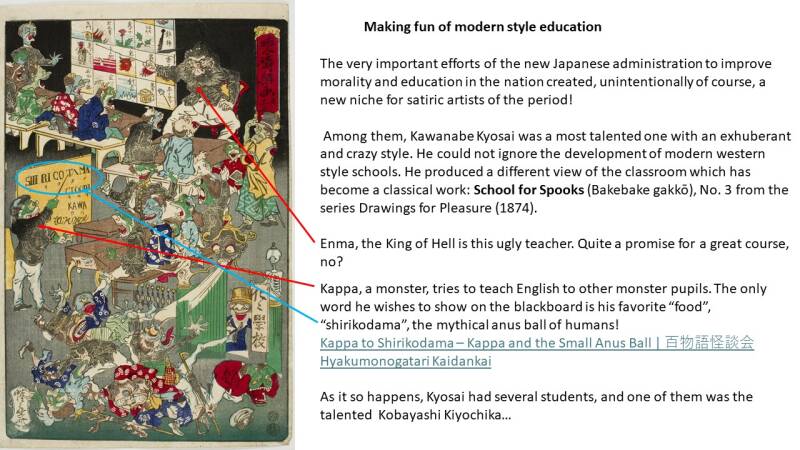During the Edo period, children attended Buddhist temple schools and learned reading, writing, and mathematics with the abacus! Japan’s literacy rate was estimated to be as high as 80% percent when the Tokugawa shogunate collapsed in 1868. It was higher than that of many Western nations.
Based on Confucian concepts, Education emphasized also moral training.
You will discover how these teachings were then conveyed to the general public through popular, and yet artistic woodblock prints.
The government of the young Emperor Meiji started at once to modernize even further and unify Japanese education after European school systems. In the absence of modern textbooks, fully illustrated and colored woodblock prints were a cheap and attractive mean to start improving education of families with children.
Over a hundred prints were produced in the 1870’s by the well known Utagawa Kuniteru II and his school in a governmental programme, the Monbushō hakkō kyōiku nishiki-e 文部省発行教育錦絵 translated as the “Pedagogical Brocade Prints published by the Ministry of Education”.
Examples for each topic are shown and commented below.
Adults are reminded of scientific principles and applications of Physics and Mechanics:
Study of Natural Laws

Adults are exposed to 14 great inventors or discoverers from the West:
here, James Watt, Bernard Palissy, Jean-Jacques Audubon and Benjamin Franklin

















These numerous government sponsored multicolored woodblock prints still have some interest from both sociological and historical reasons. They shed some light on the Japanese society and its jump into Modernity, but they retain classical Ukiyo-e woodblock layout and finesse to convey the moral and the educational messages, thanks to Kuniteru II and his school.
Soon, national textbooks would replace the Ukiyo-e…
This woodblock production,150 years ago, may lead to believe that, to some extent, present difficulties of some people with Education and Moral are inherent to the human condition. What do you think?
In their humoristic scenes of Japanese society, the great japanese satiric woodblock artists of the end of the 19th century, who pretended to criticize the governmental approach for improving Moral and Education, do emphasize the seriousness of the problem…
Thanks to:
Imre Nagy for extensive translations
Francine Minvielle for photo credits and reading proof
The Lavenberg Collection
Wikimedia Commons
Add comment
Comments